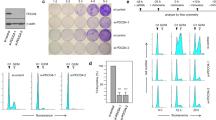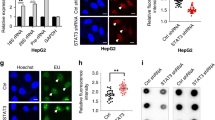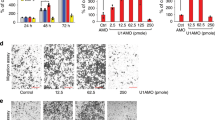Abstract
PTEN tumor suppressor serves as a major negative regulator of survival signaling mediated by PI3 kinase/AKT/protein kinase B pathway, and is inactivated in various human tumors. Elucidation of mechanisms responsible for PTEN expression is important for providing insight into strategies to control the loss of PTEN expression in human cancers. Although recent studies suggested that p53 and Egr-1 can modulate induced PTEN expression, the mechanism responsible for ubiquitous constitutive expression of PTEN remains elusive. PTEN mRNA contains a highly conserved and GC-rich 5′-untranslated region (5′-UTR). Recently, it has been shown that the long 5′-UTR sequences of several growth-regulated mRNAs contain promoters that can generate mRNAs with shorter 5′-UTRs. In this paper, we tested whether the 5′-UTR sequence of mouse PTEN contains a promoter that is responsible for constitutive expression of PTEN. We found that the long 5′-UTR sequence of mouse PTEN severely inhibits translation of PTEN and a heterologous gene firefly luciferase. Deletion of the most 5′-UTR sequence would enhance translation efficiency 100-fold. We also showed that the 5′-UTR sequence of mouse PTEN does not have an internal ribosome entry site (IRES) that can mediate cap-independent initiation of translation. Instead, we found that the 5′-UTR sequence of mouse PTEN contains a strong promoter that drives the production of a transcript with shorter 5′-UTRs, which can be translated with higher efficiency. This promoter was mapped to the region between −551 and −220 bases upstream of the translation start codon. Cotransfection analysis using Drosophila SL2 cells showed that Sp1 is one of the major transcription factors that can constitutively activate this promoter. Two endogenous PTEN transcripts with 5′-UTRs of 193 and 109 bases were found in DU145 and H226 cell lines. Based on these observations, we conclude that the PTEN expression may be regulated at both transcriptional and translational levels, and that the 5′-UTR sequence of PTEN contains a promoter that is responsible for constitutive PTEN expression.
This is a preview of subscription content, access via your institution
Access options
Subscribe to this journal
Receive 50 print issues and online access
$259.00 per year
only $5.18 per issue
Buy this article
- Purchase on Springer Link
- Instant access to full article PDF
Prices may be subject to local taxes which are calculated during checkout










Similar content being viewed by others
Abbreviations
- SL2:
-
Schneider's Drosophila cell line 2
- kb:
-
kilobase(s)
- PCR:
-
polymerase chain reaction
- 5′-UTR:
-
5′-untranslated region
- IRES:
-
internal ribosome entry site
- PAGE:
-
polyacrylamide gel electrophoresis
- mRNA:
-
messenger RNA
- RRL:
-
rabbit reticulocyte lysate
- HRV:
-
human rhinovirus
- LUC:
-
luciferase
- VEGF:
-
vascular endothelial growth factor
- PDGF:
-
platelet-derived growth factor
References
Ali IU, Schriml LM and Dean M . (1999). J. Natl. Cancer Inst., 91, 1922–1932.
Backman SA, Stambolic V, Suzuki A, Haight J, Elia A, Pretorius J, Tsao MS, Shannon P, Bolon B, Ivy GO and Mak TW . (2001). Nat. Genet., 29, 396–403.
Bernstein J, Sella O, Le SY and Elroy-Stein O . (1997). J. Biol. Chem., 272, 9356–9362.
Black AR, Black JD and Azizkhan-Clifford J . (2001). J. Cell Physiol., 188, 143–160.
Borellini F and Glazer RI . (1993). J. Biol. Chem., 268, 7923–7928.
Cantley LC and Neel BG . (1999). Proc. Natl. Acad. Sci. USA, 96, 4240–4245.
Coldwell MJ, Mitchell SA, Stoneley M, MacFarlane M and Willis AE . (2000). Oncogene, 19, 899–905.
Courey AJ and Tjian R . (1988). Cell, 55, 887–898.
Dahia PL . (2000). Endocr. Relat. Cancer, 7, 115–129.
Dennig J, Beato M and Suske G . (1996). EMBO. J., 15, 5659–5667.
Di Cristofano A and Pandolfi PP . (2000). Cell, 100, 387–390.
Gan W, LaCelle M and Rhoads RE . (1998). J. Biol. Chem., 273, 5006–5012.
Gan W and Rhoads RE . (1996). J. Biol. Chem., 271, 623–626.
Groszer M, Erickson R, Scripture-Adams DD, Lesche R, Trumpp A, Zack JA, Kornblum, HI, Liu X and Wu H . (2001). Science, 294, 2186–2189.
Gualberto A and Baldwin Jr AS . (1995). J. Biol. Chem., 270, 19680–19683.
Han B, Liu N, Yang X, Sun HB and Yang YC . (2001). J. Biol. Chem., 276, 7937–7942.
Han B and Zhang JT . (2002). Mol. Cell. Biol., 22, 7372–7384.
Hisatake J, O'Kelly J, Uskokovic MR, Tomoyasu S and Koeffler HP . (2001). Blood, 97, 2427–2433.
Huez I, Creancier L, Audigier S, Gensac MC, Prats AC and Prats H . (1998). Mol. Cell. Biol., 18, 6178–6190.
Kang YH, Lee HS and Kim WH . (2002). Lab. Invest., 82, 285–291.
Koutsodontis G, Tentes I, Papakosta P, Moustakas A and Kardassis D . (2001). J. Biol. Chem., 276, 29116–29125.
Kozak M . (1987). Nucleic Acids Res., 15, 8125–8148.
Kozak M . (1991). J. Cell. Biol., 115, 887–903.
Kozak M . (2001). Mol. Cell. Biol., 21, 1899–1907.
Kwon CH, Zhu X, Zhang J, Knoop LL, Tharp R, Smeyne RJ, Eberhart CG, Burger PC and Baker SJ . (2001). Nat. Genet., 29, 404–411.
Leslie NR and Downes CP . (2002). Cell Signal., 14, 285–295.
Li DM and Sun H . (1997). Cancer Res., 57, 2124–2129.
Li G, Robinson GW, Lesche R, Martinez-Diaz H, Jiang Z, Rozengurt N, Wagner KU, Wu DC, Lane TF, Liu X, Hennighausen L and Wu H . (2002). Development, 129, 4159–4170.
Maehama T and Dixon JE . (1999). Trends Cell Biol., 9, 125–128.
Mathews DH, Sabina J, Zuker M and Turner DH . (1999). J. Mol. Biol., 288, 911–940.
Mutter GL . (2001). Am. J. Pathol., 158, 1895–1898.
Ohlsson C, Kley N, Werner H and LeRoith D . (1998). Endocrinology, 139, 1101–1107.
Pestova TV, Kolupaeva VG, Lomakin IB, Pilipenko EV, Shatsky IN, Agol VI and Hellen CU . (2001). Proc. Natl. Acad. Sci. USA, 98, 7029–7036.
Quandt K, Frech K, Karas H, Wingender E and Werner T . (1995). Nucleic Acids Res., 23, 4878–4884.
Rao CD, Pech M, Robbins KC and Aaronson SA . (1988). Mol. Cell. Biol., 8, 284–292.
Ross AH, Lachyankar MB and Recht LD . (2001). Neuroscientist, 7, 278–281.
Sachs AB . (2000). Cell, 101, 243–245.
Salvesen HB, MacDonald N, Ryan A, Jacobs IJ, Lynch ED, Akslen LA and Das S . (2001). Int. J. Cancer, 91, 22–26.
Schneider R and Kozak M . (2001). Mol. Cell. Biol., 21, 8238–8246.
Soria JC, Lee HY, Lee JI, Wang L, Issa JP, Kemp BL, Liu DD, Kurie JM, Mao L and Khuri FR . (2002). Clin. Cancer Res., 8, 1178–1184.
Stambolic V, MacPherson D, Sas D, Lin Y, Snow B, Jang Y, Benchimol S and Mak TW . (2001). Mol. Cell, 8, 317–325.
Stambolic V, Suzuki A, de la Pompa JL, Brothers GM, Mirtsos C, Sasaki T, Ruland J, Penninger JM, Siderovski DP and Mak TW . (1998). Cell, 95, 29–39.
Stoneley M, Subkhankulova T, Le Quesne JP, Coldwell MJ, Jopling CL, Belsham GJ and Willis AE . (2000). Nucleic Acids Res., 28, 687–694.
Suzuki Y, Ishihara D, Sasaki M, Nakagawa H, Hata H, Tsunoda T, Watanabe M, Komatsu T, Ota T, Isogai T, Suyama A and Sugano S . (2000). Genomics, 64, 286–297.
Torgeman A, Mor-Vaknin N, Zelin E, Ben-Aroya Z, Lochelt M, Flugel RM and Aboud M . (2001). Virology, 281, 10–20.
Virolle T, Adamson ED, Baron V, Birle D, Mercola D, Mustelin T and de Belle I . (2001). Nat. Cell Biol., 3, 1124–1128.
Whang YE, Wu X, Suzuki H, Reiter RE, Tran C, Vessella RL, Said JW, Isaacs WB and Sawyers CL . (1998). Proc. Natl. Acad. Sci. USA, 95, 5246–5250.
Willis AE . (1999). Int. J. Biochem. Cell Biol., 31, 73–86.
Zhang JT and Ling V . (1991). J. Biol. Chem., 266, 18224–18232.
Acknowledgements
We are indebted to Dr AE Willis for pRF and pGL3RHRV plasmids, Drs Guntram Suske and Etty Benveniste for pPacO and pPacSp1 plasmids, and Dr Philip Marsden for pPac-UEts-1 plasmid. This work was supported in part by National Institutes of Health Grants CA64539 and GM59475, and by Department of Defense Grant DAMD17-02-1-0073. J-TZ is a recipient of a Career Investigator Award from the American Lung Association.
Author information
Authors and Affiliations
Corresponding author
Rights and permissions
About this article
Cite this article
Han, B., Dong, Z., Liu, Y. et al. Regulation of constitutive expression of mouse PTEN by the 5′-untranslated region. Oncogene 22, 5325–5337 (2003). https://doi.org/10.1038/sj.onc.1206783
Received:
Revised:
Accepted:
Published:
Issue Date:
DOI: https://doi.org/10.1038/sj.onc.1206783
Keywords
This article is cited by
-
Bergapten drives autophagy through the up-regulation of PTEN expression in breast cancer cells
Molecular Cancer (2015)
-
c-Jun promotes cellular survival by suppression of PTEN
Cell Death & Differentiation (2007)
-
Tumours and tremors: how PTEN regulation underlies both
British Journal of Cancer (2006)
-
The transcription factor Egr1 is a direct regulator of multiple tumor suppressors including TGFβ1, PTEN, p53, and fibronectin
Cancer Gene Therapy (2006)
-
Cloning and characterization of an HDZip I gene GmHZ1 from soybean
Planta (2005)



